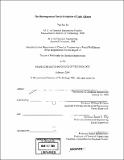The heterogeneous partial oxidation of light alkanes
Author(s)
Su, Yee San, 1977-
DownloadFull printable version (10.41Mb)
Other Contributors
Massachusetts Institute of Technology. Dept. of Chemical Engineering.
Advisor
William H. Green and Jackie Y. Ying.
Terms of use
Metadata
Show full item recordAbstract
(cont.) With this approach, an upper bound on the yield for OCM was computed. Results showed that even with optimal surface chemistry, strict limits existed on the attainable yield. Surface energetics necessary for superior OCM performance were identified and the origins of these requirements elucidated. The resulting upper bound on OCM yield under conventional, packed-bed, continuous-feed operation was found to be 28%. The catalytic properties of LiCl/sulfated ZrO₂-based catalysts were explored for ODHE. LiCl was shown to strongly interact with the acid sites on sulfated ZrO₂ (SZ), influencing its catalytic behavior. Two approaches were taken to modify the nature/strength of the LiCl-support interaction. Firstly, LiCl/Nd₂O₃-impregnated MoO/ZrO₂ and WOx/ZrO₂ were examined. Unlike SZ, these supports allowed for the tailoring of MoO[sub]x and WO[sub]x surface densities, which in turn drastically altered their ODHE performance. The poor stability of these supports, however, rendered them inferior to SZ. Secondly, the effects of dopant incorporation on the catalytic behavior of LiCI/MO,/SZ were studied. Si-doped ZrO₂-based catalysts synthesized via the sol-gel method were found to exhibit superior activity, selectivity and stability for ODHE. Sulfate decomposition experiments related the ODHE activity of these materials to the influence of the Si dopant on the sulfate binding strength. The sol-gel synthesis conditions were optimized with respect to sol pH, water:alkoxide ratio and silicon precursor, achieving improved catalyst homogeneity and enhanced ODHE performance ... Within the petrochemical industry, a sizeable economic incentive exists for the upgrading of low-value, light alkanes. For instance, the dehydrogenation of ethane to ethene is of considerable interest due to ethene's use as a polymeric and chemical precursor. Partial oxidation provides an attractive alternative to standard pyrolysis methods for alkane-to-alkene conversion. Unlike pyrolysis, partial oxidative routes are largely unaffected by coke formation and have the added benefit of exothermicity. With the inclusion of oxygen as a reactant, however, numerous additional reaction pathways result. Among these, the presence of parallel and consecutive reaction channels to CO[sub]x products is of major concern. For this reason, previous efforts to create selective partial oxidation catalysts with high activity have typically fallen below economic feasibility requirements. This thesis focuses on the following alkane-to-alkene transformation reactions: Oxidative Coupling of Methane (OCM): 2CH₄ + O₂ <--> C₂H₄ + 2 H₂O Oxidative Dehydrogenation of Ethane (ODHE): C₂H₆ + 1/2 O₂ <--> C₂H₄ + H₂O Oxidative Dehydrogenation of Propane (ODHP): C₃H₈ + 1/2 O₂ <--> C₃H₆ + H₂O. Regarding OCM, an approach was presented for determining an upper bound on the yield of a catalytic process, which allowed for variations in the catalytic chemistry. Scaling and thermodynamic arguments were used to set parameters of an elementary step surface mechanism at values resulting in optimal yields, subjected only to physical constraints. Remaining unknowns were treated as independent variables and varied over a broad range. The result was a set of thermodynamically consistent mechanisms with optimal kinetics that could be incorporated into reactor-transport models.
Description
Thesis (Ph. D.)--Massachusetts Institute of Technology, Dept. of Chemical Engineering, 2004. Includes bibliographical references.
Date issued
2004Department
Massachusetts Institute of Technology. Department of Chemical EngineeringPublisher
Massachusetts Institute of Technology
Keywords
Chemical Engineering.